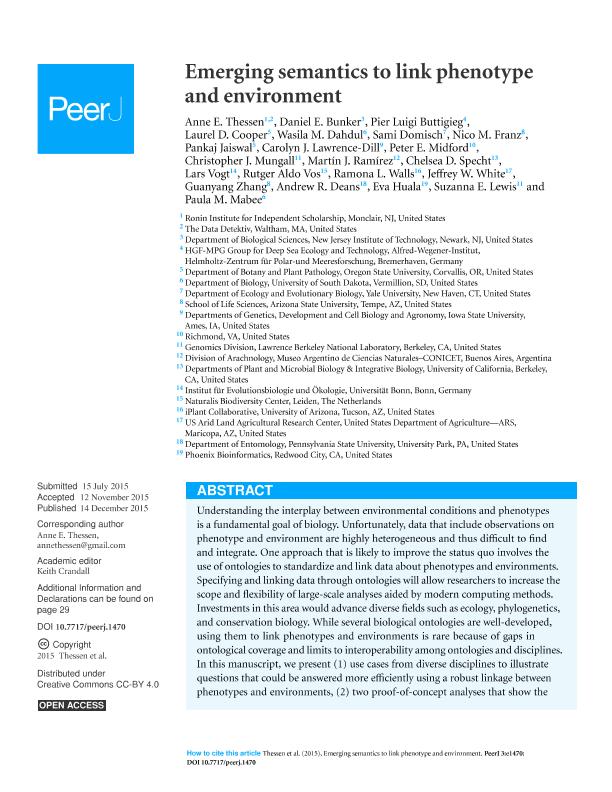Mostrar el registro sencillo del ítem
dc.contributor.author
Thessen, Anne E.
dc.contributor.author
Bunker, Daniel E.
dc.contributor.author
Buttigieg, Pier Luigi
dc.contributor.author
Cooper, Laurel D.
dc.contributor.author
Dahdul, Wasila M.
dc.contributor.author
Domisch, Sami
dc.contributor.author
Franz, Nico M.
dc.contributor.author
Jaiswal, Pankaj
dc.contributor.author
Lawrence-Dill, Carolyn J.
dc.contributor.author
Midford, Peter E.
dc.contributor.author
Mungall, Christopher J.
dc.contributor.author
Ramirez, Martin Javier

dc.contributor.author
Specht, Chelsea D.
dc.contributor.author
Vogt, Lars
dc.contributor.author
Vos, Rutger Aldo
dc.contributor.author
Walls, Ramona L.
dc.contributor.author
White, Jeffrey W.
dc.contributor.author
Zhang, Guanyang
dc.contributor.author
Deans, Andrew R.
dc.contributor.author
Huala, Eva
dc.contributor.author
Lewis, Suzanna E.
dc.contributor.author
Mabee, Paula M.
dc.date.available
2018-06-01T14:49:12Z
dc.date.issued
2015-12
dc.identifier.citation
Thessen, Anne E.; Bunker, Daniel E.; Buttigieg, Pier Luigi; Cooper, Laurel D.; Dahdul, Wasila M.; et al.; Emerging semantics to link phenotype and environment; PeerJ Inc; PeerJ; 3; 12-2015; 1-39; e1470
dc.identifier.issn
2167-8359
dc.identifier.uri
http://hdl.handle.net/11336/46968
dc.description.abstract
Understanding the interplay between environmental conditions and phenotypes is a fundamental goal of biology. Unfortunately, data that include observations on phenotype and environment are highly heterogeneous and thus difficult to find and integrate. One approach that is likely to improve the status quo involves the use of ontologies to standardize and link data about phenotypes and environments. Specifying and linking data through ontologies will allow researchers to increase the scope and flexibility of large-scale analyses aided by modern computing methods. Investments in this area would advance diverse fields such as ecology, phylogenetics, and conservation biology. While several biological ontologies are well-developed, using them to link phenotypes and environments is rare because of gaps in ontological coverage and limits to interoperability among ontologies and disciplines. In this manuscript, we present (1) use cases from diverse disciplines to illustrate questions that could be answered more efficiently using a robust linkage between phenotypes and environments, (2) two proof-of-concept analyses that show the value of linking phenotypes to environments in fishes and amphibians, and (3) two proposed example data models for linking phenotypes and environments using the extensible observation ontology (OBOE) and the Biological Collections Ontology (BCO); these provide a starting point for the development of a data model linking phenotypes and environments.
dc.format
application/pdf
dc.language.iso
eng
dc.publisher
PeerJ Inc
dc.rights
info:eu-repo/semantics/openAccess
dc.rights.uri
https://creativecommons.org/licenses/by-nc-sa/2.5/ar/
dc.subject
Phenotype
dc.subject
Environment
dc.subject
Ontology
dc.subject
Semantic Web
dc.subject
Biodiversity
dc.subject
Data Integration
dc.subject.classification
Otras Ciencias Biológicas

dc.subject.classification
Ciencias Biológicas

dc.subject.classification
CIENCIAS NATURALES Y EXACTAS

dc.title
Emerging semantics to link phenotype and environment
dc.type
info:eu-repo/semantics/article
dc.type
info:ar-repo/semantics/artículo
dc.type
info:eu-repo/semantics/publishedVersion
dc.date.updated
2018-05-24T14:24:07Z
dc.journal.volume
3
dc.journal.pagination
1-39; e1470
dc.journal.pais
Estados Unidos

dc.description.fil
Fil: Thessen, Anne E.. Ronin Institute for Independent Scholarship; Estados Unidos
dc.description.fil
Fil: Bunker, Daniel E.. New Jersey Institute of Technology; Estados Unidos
dc.description.fil
Fil: Buttigieg, Pier Luigi. Helmholtz-Zentrum für Polar-und Meeresforschung; Alemania
dc.description.fil
Fil: Cooper, Laurel D.. State University of Oregon; Estados Unidos
dc.description.fil
Fil: Dahdul, Wasila M.. University of South Dakota; Estados Unidos
dc.description.fil
Fil: Domisch, Sami. University of Yale; Estados Unidos
dc.description.fil
Fil: Franz, Nico M.. Arizona State University; Estados Unidos
dc.description.fil
Fil: Jaiswal, Pankaj. State University of Oregon; Estados Unidos
dc.description.fil
Fil: Lawrence-Dill, Carolyn J.. University of Iowa; Estados Unidos
dc.description.fil
Fil: Midford, Peter E.. No especifica;
dc.description.fil
Fil: Mungall, Christopher J.. Lawrence Berkeley National Laboratory; Estados Unidos
dc.description.fil
Fil: Ramirez, Martin Javier. Consejo Nacional de Investigaciones Científicas y Técnicas. Oficina de Coordinación Administrativa Parque Centenario. Museo Argentino de Ciencias Naturales "Bernardino Rivadavia"; Argentina
dc.description.fil
Fil: Specht, Chelsea D.. University of California at Berkeley; Estados Unidos
dc.description.fil
Fil: Vogt, Lars. Universitat Bonn; Alemania
dc.description.fil
Fil: Vos, Rutger Aldo. Naturalis Biodiversity Center; Países Bajos
dc.description.fil
Fil: Walls, Ramona L.. Arizona State University; Estados Unidos
dc.description.fil
Fil: White, Jeffrey W.. United States Department of Agriculture; Estados Unidos
dc.description.fil
Fil: Zhang, Guanyang. Arizona State University; Estados Unidos
dc.description.fil
Fil: Deans, Andrew R.. State University of Pennsylvania; Estados Unidos
dc.description.fil
Fil: Huala, Eva. Phoenix Bioinformatics; Estados Unidos
dc.description.fil
Fil: Lewis, Suzanna E.. Lawrence Berkeley National Laboratory; Estados Unidos
dc.description.fil
Fil: Mabee, Paula M.. University of South Dakota; Estados Unidos
dc.journal.title
PeerJ
dc.relation.alternativeid
info:eu-repo/semantics/altIdentifier/url/https://peerj.com/articles/1470/
dc.relation.alternativeid
info:eu-repo/semantics/altIdentifier/doi/https://dx.doi.org/10.7717/peerj.1470
Archivos asociados
